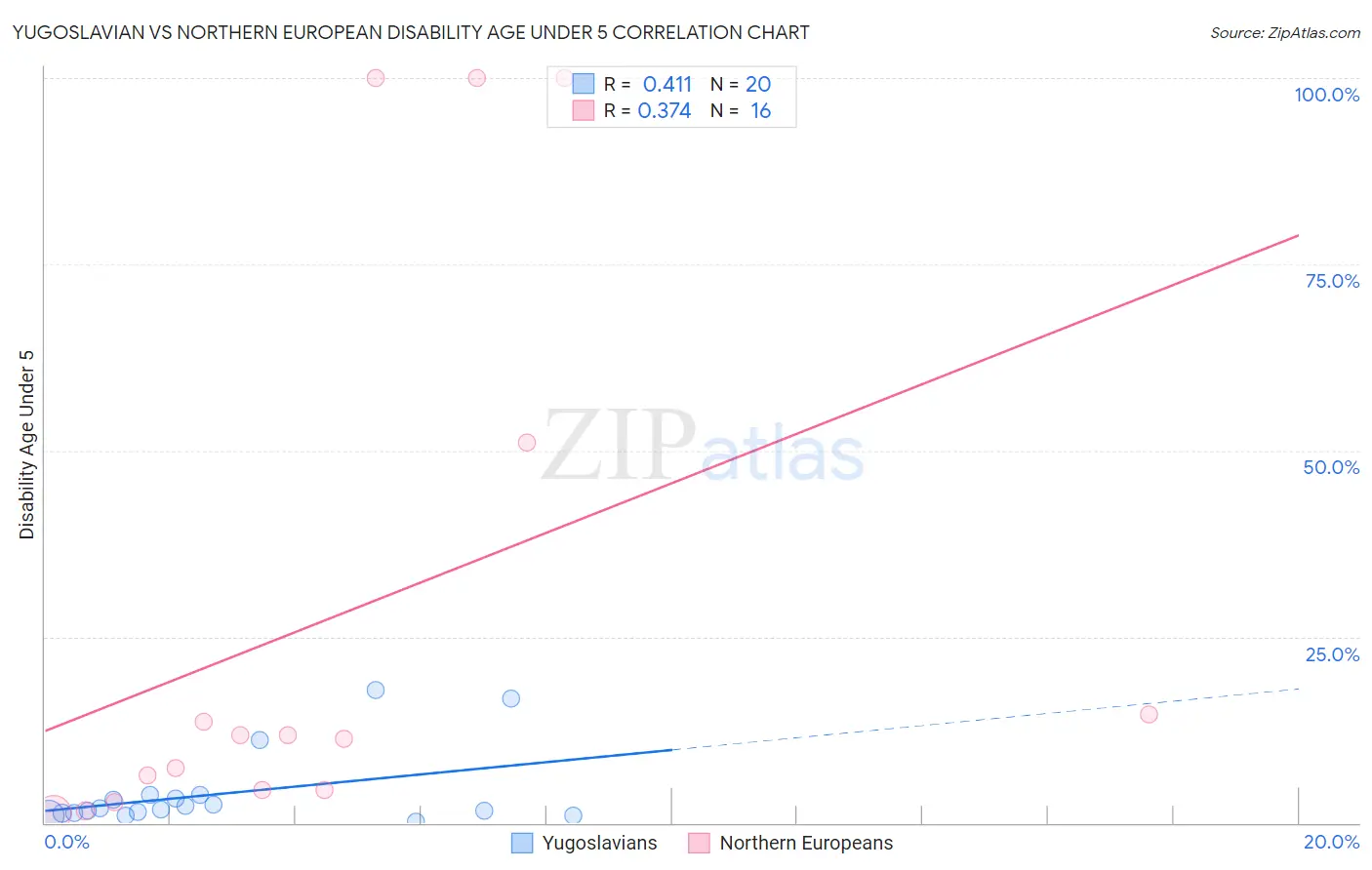Yugoslavian vs Northern European Disability Age Under 5
COMPARE
Yugoslavian
Northern European
Disability Age Under 5
Disability Age Under 5 Comparison
Yugoslavians
Northern Europeans
1.4%
DISABILITY AGE UNDER 5
0.1/ 100
METRIC RATING
264th/ 347
METRIC RANK
1.6%
DISABILITY AGE UNDER 5
0.0/ 100
METRIC RATING
291st/ 347
METRIC RANK
Yugoslavian vs Northern European Disability Age Under 5 Correlation Chart
The statistical analysis conducted on geographies consisting of 169,705,353 people shows a moderate positive correlation between the proportion of Yugoslavians and percentage of population with a disability under the age of 5 in the United States with a correlation coefficient (R) of 0.411 and weighted average of 1.4%. Similarly, the statistical analysis conducted on geographies consisting of 214,960,262 people shows a mild positive correlation between the proportion of Northern Europeans and percentage of population with a disability under the age of 5 in the United States with a correlation coefficient (R) of 0.374 and weighted average of 1.6%, a difference of 9.1%.

Disability Age Under 5 Correlation Summary
| Measurement | Yugoslavian | Northern European |
| Minimum | 0.18% | 1.2% |
| Maximum | 17.9% | 100.0% |
| Range | 17.7% | 98.8% |
| Mean | 3.9% | 27.6% |
| Median | 1.9% | 11.5% |
| Interquartile 25% (IQ1) | 1.3% | 4.4% |
| Interquartile 75% (IQ3) | 3.5% | 32.8% |
| Interquartile Range (IQR) | 2.2% | 28.4% |
| Standard Deviation (Sample) | 5.1% | 37.7% |
| Standard Deviation (Population) | 5.0% | 36.5% |
Similar Demographics by Disability Age Under 5
Demographics Similar to Yugoslavians by Disability Age Under 5
In terms of disability age under 5, the demographic groups most similar to Yugoslavians are Carpatho Rusyn (1.4%, a difference of 0.040%), Immigrants from Germany (1.4%, a difference of 0.080%), Spanish (1.4%, a difference of 0.15%), Immigrants from Dominica (1.4%, a difference of 0.21%), and Immigrants from Netherlands (1.4%, a difference of 0.37%).
| Demographics | Rating | Rank | Disability Age Under 5 |
| Slovenes | 0.3 /100 | #257 | Tragic 1.4% |
| Costa Ricans | 0.3 /100 | #258 | Tragic 1.4% |
| Immigrants | Southern Europe | 0.3 /100 | #259 | Tragic 1.4% |
| Slavs | 0.3 /100 | #260 | Tragic 1.4% |
| Immigrants | Netherlands | 0.2 /100 | #261 | Tragic 1.4% |
| Immigrants | Dominica | 0.2 /100 | #262 | Tragic 1.4% |
| Spanish | 0.2 /100 | #263 | Tragic 1.4% |
| Yugoslavians | 0.1 /100 | #264 | Tragic 1.4% |
| Carpatho Rusyns | 0.1 /100 | #265 | Tragic 1.4% |
| Immigrants | Germany | 0.1 /100 | #266 | Tragic 1.4% |
| Cree | 0.1 /100 | #267 | Tragic 1.4% |
| Belgians | 0.1 /100 | #268 | Tragic 1.4% |
| Austrians | 0.1 /100 | #269 | Tragic 1.4% |
| Immigrants | North America | 0.1 /100 | #270 | Tragic 1.4% |
| Immigrants | Canada | 0.1 /100 | #271 | Tragic 1.4% |
Demographics Similar to Northern Europeans by Disability Age Under 5
In terms of disability age under 5, the demographic groups most similar to Northern Europeans are Czech (1.5%, a difference of 0.10%), Italian (1.6%, a difference of 0.14%), Hungarian (1.5%, a difference of 0.22%), Estonian (1.5%, a difference of 0.36%), and Scandinavian (1.5%, a difference of 0.54%).
| Demographics | Rating | Rank | Disability Age Under 5 |
| Europeans | 0.0 /100 | #284 | Tragic 1.5% |
| Croatians | 0.0 /100 | #285 | Tragic 1.5% |
| Tlingit-Haida | 0.0 /100 | #286 | Tragic 1.5% |
| Scandinavians | 0.0 /100 | #287 | Tragic 1.5% |
| Estonians | 0.0 /100 | #288 | Tragic 1.5% |
| Hungarians | 0.0 /100 | #289 | Tragic 1.5% |
| Czechs | 0.0 /100 | #290 | Tragic 1.5% |
| Northern Europeans | 0.0 /100 | #291 | Tragic 1.6% |
| Italians | 0.0 /100 | #292 | Tragic 1.6% |
| Lithuanians | 0.0 /100 | #293 | Tragic 1.6% |
| Swedes | 0.0 /100 | #294 | Tragic 1.6% |
| Finns | 0.0 /100 | #295 | Tragic 1.6% |
| Poles | 0.0 /100 | #296 | Tragic 1.6% |
| Immigrants | Nonimmigrants | 0.0 /100 | #297 | Tragic 1.6% |
| Cajuns | 0.0 /100 | #298 | Tragic 1.6% |